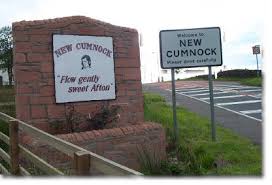Scotland is a nation of towns half our population live in them. So why have they become so invisible in our culture? Larger towns rush to become cities, smaller towns call themselves villages. Our cities dominate in soap opera and cop drama, in contemporary literary and crime fiction. Together with the natural environment, cities drive our tourism promotion. Our towns, it seems, have an identity crisis.
I suspect that part of the problem is a ‘kailyard’ hangover. There may be a subconscious fear that showing too much interest in towns will label you parochial, unadventurous, backward-looking. So, if we’re talking about the role of creativity in regenerating our town centres, we have to start with the stories we tell the world, and ourselves, about our towns. Every town, after all, has a unique story to tell.
Take New Cumnock, 2013 winner of the Carbuncle Award as ‘Scotland’s most dismal town’. There’s no doubt that New Cumnock faces a complex web of social and economic problems, yet someone cares enough about the place to put together a website http://members.tripod.com/bob_newcumnock/nchome/welcomex.html that documents the town’s rich history, from Bronze Age graves to Glenafton Athletic winning the Scottish Junior Cup in 1993. And another fine website on New Cumnock Heritage has been put together by the New Cumnock Liaison Group. I’m sure that with a little digging I’d find that there are several active amateur music, dance and drama groups in and around the town, like the wonderfully named Cumnock Area Musical Productions Society, or CAMPS, for short.
In other words, like most towns, New Cumnock and its environs have a complex cultural history and life, that’s too easily made invisible by focusing only on a town’s problems. François Matarasso, author of important cultural mapping studies on Orkney and Aberdeenshire, has written a moving and inspiring little book about the importance to a community of that much-maligned institution, the amateur operatic society. Where we dream http://regularmarvels.com/1-where-we-dream tells the story of West Bromwich Operatic Society and its remarkable 75 year history of bringing skills, pleasure, and cohesion to one of the most deprived areas in the UK. It should be required reading for anyone who needs persuading of the central role of creativity in regeneration.
cultural history and life, that’s too easily made invisible by focusing only on a town’s problems. François Matarasso, author of important cultural mapping studies on Orkney and Aberdeenshire, has written a moving and inspiring little book about the importance to a community of that much-maligned institution, the amateur operatic society. Where we dream http://regularmarvels.com/1-where-we-dream tells the story of West Bromwich Operatic Society and its remarkable 75 year history of bringing skills, pleasure, and cohesion to one of the most deprived areas in the UK. It should be required reading for anyone who needs persuading of the central role of creativity in regeneration.
The activities of such groups, and of institutions such as local museums, heritage centres and history societies, can be a vital measure of the social cohesion of a town, and of the foundations on which a programme of regeneration can be built, but of course these are the very areas that are currently under pressure as Local Authorities cut budgets for anything that isn’t seen as statutory or necessary. Often it’s the very modesty of the sums involved, a few hundred here, a few thousand there, or their misleading labelling as ’discretionary’ grants, that make them so easy to cut, but the damage inflicted can be out of all proportion to the sums involved.
At a more professional level, cultural institutions can themselves become major drivers for change. We need a comprehensive, in-depth study of the impact of the ‘theme towns’ concept, whether centrally-designated (Wigtown Book Town) or locally-initiated (West Kilbride Crafttown Scotland, or Kirkcudbright Artists’ Town). There’s nothing to say Scotland has room for only one Craft or Book town, and what about other themes? Given Scotland’s role in the early days of the medium, surely there’s room for a Photography town, for instance, never mind a dance town or, even a country and western town (actually, it looks like Dingwall’s in the running for that one! http://www.dingwall.org.uk/News/Events-Calendar/Hooley-In-The-Highlands.aspx )
There’s a win/win situation to be reached here. Cultural groups and institutions can help secure their own sustainable futures by placing themselves more at the heart of their communities, as anchor organisations for wider regeneration programmes. The Woodend Arts Association in Banchory, for example, in partnership with the Leys Estate, has established 120 allotments plots in the last ten years. http://www.woodendbarn.com/allotments Timespan Museum and Arts Centre has become the largest single employer in Hemsdale http://timespan.org.uk . But sometimes a community can fail to realise just how important the creative sector has become: Tain is host to a remarkable number of high quality arts and craft businesses, from one of the most-highly regarded galleries in the Highlands, to the finest Glass Studio north of Sunderland, and from Tain Pottery to Anta, based just outside the town. Yet Tain’s community website gives not a hint of this hive of creative activity, as something that could give Tain a USP compared with all its rivals up the spine of the A9.
As Nicholas Crane stated in the introduction to his recent BBC series Town, towns are where we learned to be urban, but they are also the future. The Scottish Government’s recent Town Centre Review http://www.scotland.gov.uk/Publications/2013/07/7250 is a welcome step in the right direction, but all the discounts in business rates and changes in planning legislation will only work if we start by understanding the culture of each individual town, and tap the creative energies of each town to rewrite its own story.

